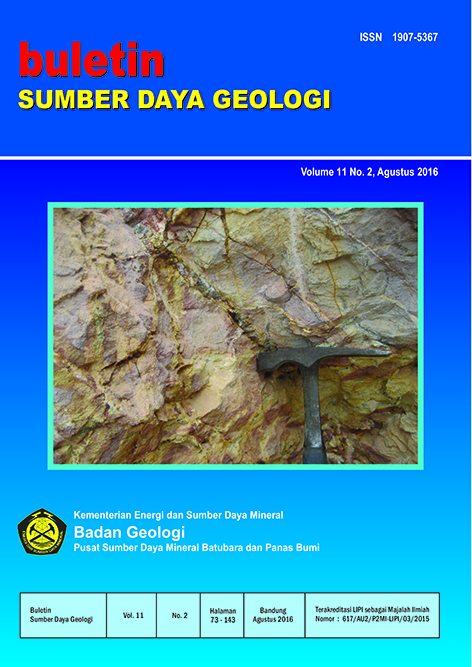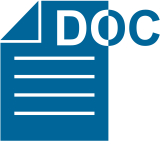KARAKTERISTIK CEBAKAN TIMAH PRIMER DI DAERAH PARIT TEBU, KABUPATEN BELITUNG TIMUR, PROVINSI KEPULAUAN BANGKA BELITUNG
Abstract
Endapan timah sekunder banyak tersebar dan ditambang di wilayah Kabupaten Belitung Timur namun belum jelas dari mana sumber potensial cebakan timah primernya. Survei geofisika dengan metoda polarisasi terimbas (IP) dan magnetik di daerah tersebut menghasilkan beberapa anomali mengindikasikan adanya terobosan batuan granit yang diduga sebagai sumber cebakan timah. Hasil penelitian terbaru dengan metoda pengeboran inti dan analisisis laboratorium yang meliputi Atomic Absorption Spectrometry (AAS), X-Ray Fluorescence (XRF), petrografi dan mineragrafi menunjukkan mineralisasi timah primer mempunyai bentuk cebakan berupa urat-urat halus dan sebagian tersebar dalam masa batuan. Mineralisasi terjebak dalam batupasir kuarsa arenit dan metabatulempung akibat diterobos oleh granit aplitik. Mineralisasi timah dicirikan oleh hadirnya kasiterit yang berasosiasi dengan realgar, molibdenit dan beberapa mineral sulfida seperti pirit, sfalerit, galena dan arsenopirit dalam mineral gangue kuarsa. Genesa cebakan diklasifikasikan sebagai tipe urat hidrotermal dengan kandungan kaya timah terkonsentrasi pada zona urat kuarsa yang terbreksikan.
Downloads
References
Anonim, 2001, Exploration report on Belitung Project, Belitung Island, Join Venture between PT. Timah and Herald Resources Ltd.
Azis, Y.M., dan S. Widodo, 2014, Survei Polarisasi Terimbas (IP) dan Geomagnit Daerah Parit Tebu Kecamatan Gantung Kabupaten Belitung Timur, Provinsi Kepulauan Bangka Belitung, Pusat Sumber Daya Geologi, Bandung.
Baharudin dan Sidarto, 1995, Peta Geologi Lembar Belitung, Sumatera, sekala 1: 250.000, Pusat Penelitian dan Pengembangan Geologi, Bandung.
Chappel, B.W., and White, A.J.R., 1974. Two contrasting granite types,
Pacific Geol., 8, 173-174.
Hoover, D.B., Heran, W.D., and Hill, P.L., 1992, The geophyasical expression of selected mineral deposit models: U.S. Geological Survey Open-File Report 92-557, 129 p.
Ishihara, S., 1980, Granitic Magmatism and Related Mineralization, Mining Geology Special Issue No.8, 1980, The Society of Mining Geology of Japan, p. 13-28.
Lehmann, B., 1990, Metallogeny of Tin. Lecture notes in Earth Sciences., 32. Springer-Verlag, Berlin.
Reed, B.L., 1986 a, Descriptive model of Sn veins, in Cox, D.P., and Singer, D.A., eds, Mineral deposit models; U.S. Geological Survey Bulletin 1963, p.70.
Rose, A.W., Hawkes, H.E., and Webb, J.S., 1979, Geochemistry in mineral exploration: Academic Press, 657 p.
Schwartz, M.O. dan Surjono, 1990. The Stratabound deposit of Namsalu Kelapakampit, Indonesia. Econ. Geol. 95. 76-98.
Soepriadi dan Abidin, H.Z., 2014, Laporan Penyelidikan Untuk Menentukan Wilayah Pengeboran Eksplorasi Mineral Logam Timah Primer Dan Logam Lainnya, Daerah Parit Tebu dan Lintang, Kecamatan Gantung, Kabupaten Belitung Timur, Provinsi Kepulauan Bangka Belitung, Pusat Sumber Daya Geologi, Badan Geologi Bandung.
Soepriadi dan Bambang. P., 2015, Laporan Penelitian dan Evaluasi Hasil Pengeboran Logam Timah Primer di Daerah Parit Tebu, Kecamatan Gantung, Kabupaten Belitung Timur, Provinsi Kepulauan Bangka Belitung, Pusat Sumber Daya Geologi, Badan Geologi, Bandung.
Whitten, D.G.H., and Brooks, J.R.V., 1072, Dictionary of Geology, Penguin Books Ltd., London
Copyright (c) 2017 Buletin Sumber Daya Geologi

This work is licensed under a Creative Commons Attribution-NonCommercial-ShareAlike 4.0 International License.
Authors whose manuscripts are published agree to the following terms:
The publication rights of all journal manuscript materials published on the Buletin Sumber Daya Geologi website are held by the editorial board with the knowledge of the author (moral rights remain with the manuscript’s author).
The formal legal provisions for access to digital articles in this electronic journal are subject to the terms of the Creative Commons Attribution-ShareAlike (CC BY-SA) license. This means that Buletin Sumber Daya Geologi has the right to store, convert media/formats, manage in the form of a database, maintain, and publish the article without requesting permission from the author, as long as the author’s name is cited as the copyright holder.
Manuscripts published in both print and electronic formats are open access for educational, research, investigative, and library purposes. Beyond these purposes, the editorial board is not responsible for any violations of copyright law.















